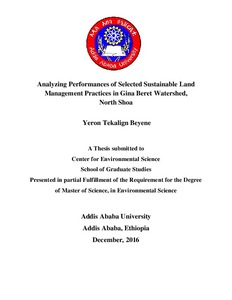Analyzing performances of selected sustainable land management practices in Gina Beret Watershed, North Shoa
Abstract
The study was conducted at Basona Werana Woreda North Shewa zone. Land degradation, which includes degradation of vegetation cover, soil degradation and nutrient depletion, is a major ecological problem generally in Ethiopia and particularly in the study area. As a response of the ever expanding land degradation, rehabilitation of degraded lands through intervention of Sustainable land management has been practiced in the study area. Despite these efforts, there are no studies in the area, which would provide information on the effectiveness of different intervened sustainable land management practices for further up scaling in the study area. The main aim of the study is to identify, characterize and examine the performance of selected sustainable land management practices in the study area. Selected sustainable land management practices include Tree Lucerne with stone bund, Phalaris with Stone bund, only stone bund, which was introduced in the past three years and area without Sustainable Land Management practice as a control was compared with each other in selected farm lands. All 30 houses hold farmers of the watershed, 5 five key informants and 12 farm lands were selected purposively for the survey and data obtained from agriculture experts of the Kebele. Data collection method include transect work, questionnaire survey, key informant interviews and field observation. Transects were used to collect soil samples and questionnaires to gather the necessary information from the sampled households and key informants. A total of 24 soil samples were taken from selected areas. Six soil samples were taken from each practice site. The samples were compared for selected nutrient. The results of soil chemical property analysis revealed that, the status of soil organic matter, total nitrogen and available phosphorous of the soil with each selected sustainable land management practice showed significant difference. Sustainable land management practices improved farm land soil fertility through maintaining organic matter and plant nutrients and improving soil structure increasing water infiltration and reducing run off. The reason for soil fertility differences may not only be the introduction of set of sustainable land management practices but also to the difference in land management history of the farm lands. The decline in fertility of the soil without the practices may be the removal of plant nutrient by erosion and depletion of soil. The farmers prioritize sustainable land management practices phalaris with stone bund first Tree Lucerne with stone bund second and finally the stone bund are very effective in improving farm land soil fertility. Finally, based on the findings of the study, it has been recommended that farmers has to be encouraged and need to be aware from planning phase to implementation in improving the quality of measures. They have to protect bunds from grazing, practice cut and carry for stall feeding and carry out the maintenance of the structures by themselves. They have to introduce combinations of land management practices with good land management for effective crop land improvement in order to achieve sustainability and food security.

